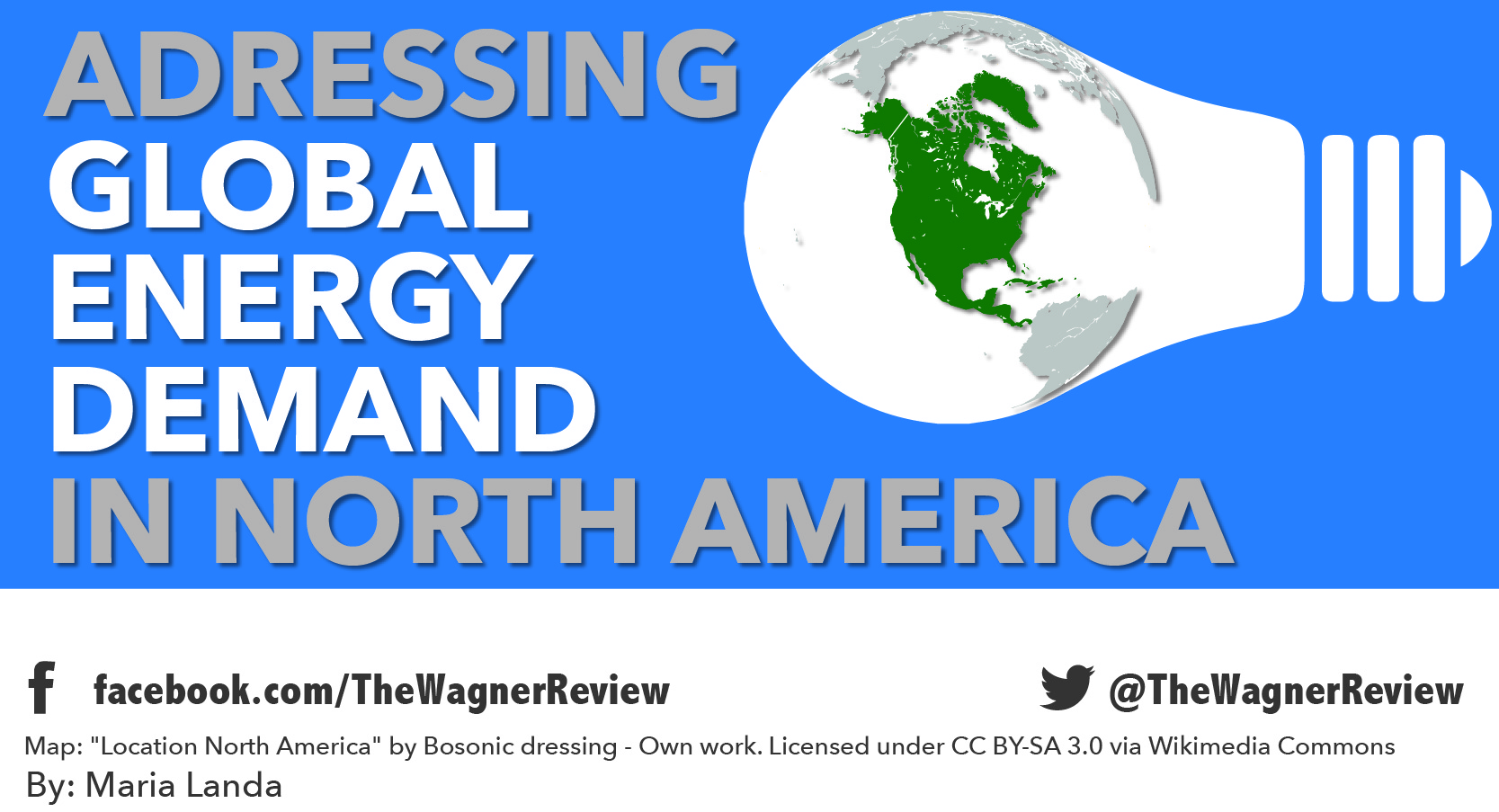By 2030, global energy demand will increase by 41 percent due to rapid population and economic growth. Between 2012 and 2035, global population is projected to grow by 1.7 billion and real (or inflation-adjusted) income will more than double. In order to promote more energy efficient activities that curb greenhouse gas emissions and slow growth related to demand, both developed and emerging economies have placed environment and climate policies high on their political agendas. Yet, the latest scenario by the International Energy Agency World Energy Outlook estimates that in 2040, oil and gas will remain the backbone of energy supply, making up nearly half of the total energy supply – with the remainder coming from coal and low-carbon fuels.
 Canada, Mexico, and the U.S. will play critical roles in meeting the demand, tackling pressure on the global energy system, and contributing to energy security. With the abundance of U.S. natural gas and oil reserves, Canada’s oil sands and Mexico’s landmark constitutional energy reform (which opened its energy sector to private investment for the first time), North America is now considered an energy superpower. Leading think tanks and political leaders are urging the U.S. not only to strengthen ties with its North American neighbors, but also to make the trilateral relationship a priority in U.S. policy. The Council on Foreign Relations recently released a report led by former CIA Director David Petraeus and former World Bank president, Robert Zoellick, indicating that increased production and innovation in the energy sector coupled with China’s labor and shipping costs, boost North America’s global competitive advantage.
Canada, Mexico, and the U.S. will play critical roles in meeting the demand, tackling pressure on the global energy system, and contributing to energy security. With the abundance of U.S. natural gas and oil reserves, Canada’s oil sands and Mexico’s landmark constitutional energy reform (which opened its energy sector to private investment for the first time), North America is now considered an energy superpower. Leading think tanks and political leaders are urging the U.S. not only to strengthen ties with its North American neighbors, but also to make the trilateral relationship a priority in U.S. policy. The Council on Foreign Relations recently released a report led by former CIA Director David Petraeus and former World Bank president, Robert Zoellick, indicating that increased production and innovation in the energy sector coupled with China’s labor and shipping costs, boost North America’s global competitive advantage.
North America: Two Decades after NAFTA
2014 marked the 20th anniversary of the North American Free Trade Agreement (NAFTA) that established a free-trade zone between Canada, Mexico, and the United States. The agreement, which came into effect in 1994, laid the foundation for strong economic growth in the region. Canada and Mexico are vital to the U.S. economy and since the agreement began, trade between Canada and Mexico has more than tripled to $1.2 trillion USD and now supports 14 million U.S. jobs. Canada is the largest trading partner to the U.S., with Mexico as the third (China is second). Yet despite the initial success of this relationship, NAFTA has become increasingly stagnant over the past decade. Instead of remaining a strong regional agreement, over the last several years, discussions at the North American Leaders Summit, a trilateral annual summit often referred as the Three Amigos Summit, have focused on bilateral security and trade between either the U.S. and Canada or the U.S. and Mexico. According to Diana Negroponte, a non-resident Senior Fellow at the Brookings Institution, North America could benefit from economies of scale if it acted as an integrated value chain delivering products and services in a more efficient way. The energy sector has potential for these efficiencies. A combination of factors including regional planning policy, regulatory collaboration, and private sector involvement of construction of pipelines and infrastructure would help North America realize energy security. Further, regional policy adoption of fuel efficiency measures, and a shift from gasoline and diesel to natural gas and electrical power, will augment this improvement.
Canada: A Vital Piece of the Puzzle
The Energy Action Group (EAG) of the Council of the Americas recently released a report emphasizing Canada’s relevance as an energy partner to the U.S. and Mexico. Canada’s economy depends on its natural resources and is the largest supplier of U.S. energy, providing a variety of products ranging from gas and oil to renewables like hydropower. One of the proposed strategies to enhance this integration is the approval of the Keystone XL pipeline. The pipeline is expected to transport 830,000 barrels of oil per day from Canada to refineries in the Gulf Coast. However, its construction has been hotly debated. Proponents argue that the pipeline will generate job growth and that the increased production will respond to the increased demand related to decreasing production in Mexico and Venezuela. Opponents are concerned with the environmental impact associated with greenhouse gas emissions in the oil sands. The EAG report argues that the impact to emissions and safety are less than those related to moving oil through rail and road alternatives. As a result of the delay in the pipeline’s approval, Canada has begun to diversify its energy markets with a growing focus on Asia. The Keystone XL pipeline is just one example of the potential of Canada as an energy superpower. North American integration would allow the fuel shipped to the Gulf Coast to be refined and exported internationally, both benefiting the Canadian energy market and the regional economy. However, it is important that any dialogue on energy infrastructure be accompanied by discussions related to the environmental impact at the cabinet level.
Mexico’s Upcoming Energy Revolution
Mexico and the U.S. are close energy partners. After Canada and Saudi Arabia, Mexico is the third largest oil supplier and the U.S. is Mexico’s main supplier of gasoline and natural gas. Mexico is a net crude exporter, however its production has declined in the last decade primarily due to underinvestment and a natural production decline in aging oil fields. Mexico has reformed its energy sector under the administration of President Enrique Peña Nieto and changes are promising for North America competition. Mexico passed a landmark bill in December 2013, and secondary legislation was enacted in August 2014. This ended a 76-year monopoly held by Mexico’s state oil company Petroleos Mexicanos (Pemex) over oil and gas. For the first time in Mexican history, this major energy reform legislation will allow the private sector to invest in joint ventures with Pemex in areas of exploration and exploitation of Mexico’s oil and gas resources. Ultimately, this reform aims to increase Mexico’s competitive edge and drive economic growth, and it has already begun to attract foreign companies.
Regional Energy Perspective & Policy Recommendations
Canada, Mexico, and the U.S. have undertaken several efforts to shift toward a long-term regional energy strategy. For example, in December 2014, the Energy Ministers of each country met to “discuss opportunities to promote common strategies on energy efficiency, infrastructure, innovation, renewable energy, unconventional energy sources, energy trade, and responsible resource development.†Only through a synergized, regional approach, will these countries be able to take advantage of the numerous opportunities and overcome challenges driven by change in the energy landscape. According to the Duncan Wood, Mexico Institute Director at the Wilson Center, the U.S. is in a unique position to satisfy a large energy demand given current resources and has even surpassed Saudi Arabia as the world’s largest producer. If an integration of the three countries’ energy markets is achieved, this positioning of the U.S. as the largest producer coupled with an increase in production from Canada and Mexico has the potential to turn North America into an exporter of hydrocarbons, rather than an importer. However, these countries face two challenges that are key in North America’s future competitiveness: lack of investments in infrastructure, and human capital.
First, there is a need for infrastructure development in Canada, Mexico, and the United States. For instance, Canada needs pipelines to get the best value for its oil; the U.S. requires liquefied natural gas facilities consistent with the shale revolution and exports potential; and Mexican refineries are in great need of modernization. Second, even with this new infrastructure, these countries are in great need of human capital in the energy sector such as pipefitters, engineers, and electricians.
As a result, there are three main elements that policymakers should consider: (1) infrastructure projects must be suited to the supply and demand needs of the region, (2) infrastructure must be protected through the involvement of the pertinent energy and security agencies, and (3) design of programs and partnerships must take into account the public and private sector in order to satisfy the need for professionals and confront the skills gap and shortage of human capital.
Canada, Mexico and the U.S. have a long-standing relationship and there is potential to achieve regional integration. By addressing infrastructure, human capital, and these three policy considerations, the North American energy strategy will be able to respond to the growing global energy demand and strengthen the region’s position in the world.
Maria Landa is a Master of Urban Planning candidate at NYU Wagner, specializing in international development planning. While at NYU she has interned at the Executive Office of the United Nations Development Programme in New York, and the Woodrow Wilson International Center for Scholars in Washington, D.C where she performed research on energy. She believes in international cooperation for development, social media and explaining the world through infographics.




